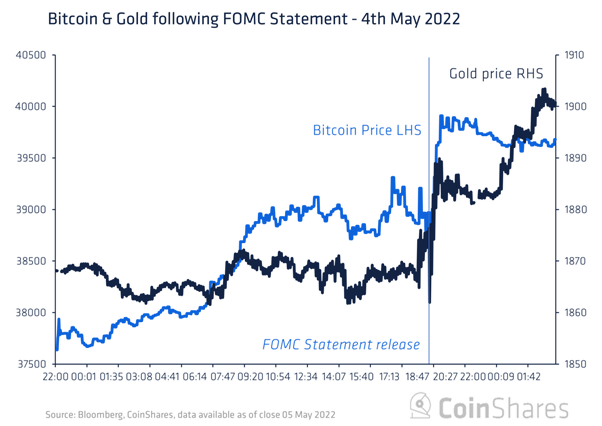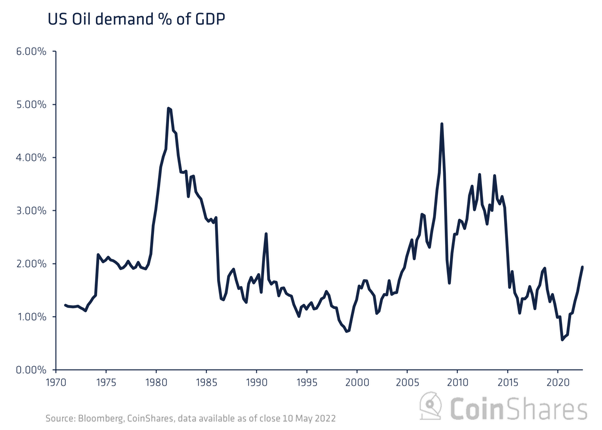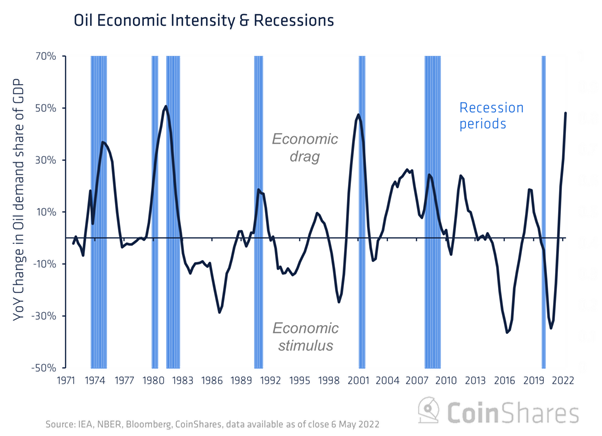With the just-released CPI data from the United States, it is easy to believe that the US Federal Reserve (FED) will be increasingly hawkish on interest rates, hence negative for Bitcoin prices. Due to oil prices and the threat of recession, we believe the FED has limited firepower, however.
Bitcoin now has a well-established inverse correlation to the US dollar. This makes sense due to its emerging store of value characteristics, but it also makes it incredibly sensitive to interest rates. The price declines over the last 6 months can, by and large, be explained as a direct result of increasingly hawkish rhetoric from the FED. The Federal Open Markets Committee (FOMC) statements are a good indicator of this, and we can observe a clear connection to statement release times and price moves.

The most recent FOMC meeting was initially seen as less hawkish than expected and so both Bitcoin and Gold prices reacted positively, only to fall later in the day as investors digested the comments further — the consensus opinion interpreting the data as more hawkish than initially thought.
The biggest challenge for investors is to determine how sustained the US Dollar strength will be. One could argue that much of the market expectations on US interest rate hikes have now been fully priced in. Some economic data is beginning to roll-over, such as wage growth and purchasing manager indices but perhaps the most worrying indicator is the impact oil prices are having on the US and the global economy.
One measure to ascertain the impact of oil prices on the US economy is to measure the percentage of oil demand relative to current GDP. At first glance this isn’t particularly alarming at just under 1.9%, bang on the long-term average. At peak periods it has been as high as 4.9% and as low as 0.5% when looking back as early as 1970.

Interestingly, just prior to the Iranian revolution in 1978 oil demand as a percentage of GDP was the same level it is today at 1.9%. History has indeed shown that oil demand as a percentage of GDP can creep up and not cause too much economic malaise on its own.
It is the speed at which oil demand changes which creates the problem. The effects are what we typically refer to as oil price shocks, and they are most commonly associated with international conflicts. This can be measured by the change in oil demand as a percentage of GDP, as highlighted in the chart below.

Historically, sharp rises in oil demand have almost always been followed by economic recessions in the United States. They have typically been prompted by major oil crises such as Yom Kippur in 1973, the Iranian Revolution in 1978–79, the first Iraq War in 1990 and 911 in 2001. The only two exceptions were the great financial crisis in 2008 and the recent Covid pandemic.
The Ukraine war has already exacerbated the economic woes caused by Covid, but it is too early to see this fully reflected in economic data. The economic drag caused by sanctions and oil price shocks is further being exacerbated by an aggressive interest rate tightening cycle by the FED, in an attempt to rein-in inflation.
The FED’s prior intransigence to inflation is now being born-out in a much more aggressive knee-jerk approach. This is happening at an unfortunate time as the federal debt growth from 30% of GDP to over 100% today has severely reduced the policy flexibility it enjoyed to combat inflation in the 1980s. Producer prices in the US are now at the highest levels seen since 1975, and as this trickles down to the broader economy, either in the form of tighter corporate earnings or rising costs of goods, it will be a significant impediment to growth.
While we believe we are likely to see the US Federal Reserve continue to hike rates through the summer, we also believe they are likely to adopt a softer outlook on economic growth thereafter, prompting considerable dollar weakness.
The FED has a fine needle to thread, engineering a soft landing for economic growth while taming inflation. This is particularly challenging as many involved factors are out of their control, such as the Ukraine war and its influences on oil prices. Inflation can probably be tamed, but at what price? History suggests the price will be an economic recession.
How is all this Related to Crypto?
Bitcoin is increasingly being seen as a hedge against central bank monetary policy errors — what happens if this massive quantitative easing experiment over the last 12 years ends badly? Particularly in light of the current inflationary challenges?
It will lead to huge currency volatility, and at that point, Bitcoin is likely to be seen as an anchor — as it is increasingly being seen in places where currency volatility is already a reality such as Lebanon, Venezuela and Turkey.
We are certainly not saying an emerging market style collapse will happen in the developed world. Our argument is that debt levels are now such that central banks in the developed world have limited firepower to engineer a soft economic landing, threatening their safe haven/reserve currency status. This is likely to lead to softer monetary policies in the second half of the year and weaker currencies. While Bitcoin’s price performance has been weak in the face of an aggressive FED, this current hiatus in price-performance may very well be short-lived.




